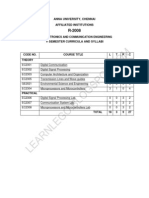DSP Syllabus Eee
Uploaded by
Venu NookalaDSP Syllabus Eee
Uploaded by
Venu NookalaEC2314 DIGITAL SIGNAL PROCESSING
To introduce the concept of analyzing discrete time signals & systems in the time and
frequency domain.
OBJECTIVES
To classify signals and systems & their mathematical representation.
To analyse the discrete time systems.
To study various transformation techniques & their computation.
To study about filters and their design for digital implementation.
To study about a programmable digital signal processor & quantization effects.
UNIT I INTRODUCTION
Classification of systems: Continuous, discrete, linear, causal, stable, dynamic, recursive,
time variance; classification of signals: continuous and discrete, energy and power;
mathematical representation of signals; spectral density; sampling techniques, quantization,
quantization error, Nyquist rate, aliasing effect. Digital signal representation.
UNIT II DISCRETE TIME SYSTEM ANALYSIS
Z-transform and its properties, inverse z-transforms; difference equation Solution by ztransform, application to discrete systems - Stability analysis, frequency response
Convolution Fourier transform of discrete sequence Discrete Fourier series.
UNIT III DISCRETE FOURIER TRANSFORM & COMPUTATION
DFT properties, magnitude and phase representation - Computation of DFT using FFT
algorithm DIT & DIF - FFT using radix 2 Butterfly structure.
UNIT IV DESIGN OF DIGITAL FILTERS
FIR & IIR filter realization Parallel & cascade forms. FIR design: Windowing Techniques
Need and choice of windows Linear phase characteristics. IIR design: Analog filter design
Butterworth and Chebyshev approximations; digital design using impulse invariant and
bilinear transformation - Warping, Prewarping - Frequency transformation.
UNIT V DIGITAL SIGNAL PROCESSORS
Introduction Architecture Features Addressing Formats Functional modes Introduction to Commercial Processors
TOTAL = 60 PERIODS
TEXT BOOKS
1. J.G. Proakis and D.G. Manolakis, Digital Signal Processing Principles, Algorithms
and Applications, Pearson Education, New Delhi, 2003 / PHI.
2. S.K. Mitra, Digital Signal Processing A Computer Based Approach, Tata McGraw
Hill, New Delhi, 2001.
You might also like
- Ee8591 Digital Signal Processing Unit I IntroductionNo ratings yetEe8591 Digital Signal Processing Unit I Introduction2 pages
- Ee8591 Digital Signal Processing L T P C 2 2 0 3No ratings yetEe8591 Digital Signal Processing L T P C 2 2 0 33 pages
- Text Books:: Ee6403 Discrete Time Systems and Signal Processing Unit I Introduction 9No ratings yetText Books:: Ee6403 Discrete Time Systems and Signal Processing Unit I Introduction 91 page
- Objectives:: at The End of The Course, The Student Should Be Able ToNo ratings yetObjectives:: at The End of The Course, The Student Should Be Able To2 pages
- Discrete Time Signal Processing SyllabusNo ratings yetDiscrete Time Signal Processing Syllabus2 pages
- Course Information Sheet: Course Coordinator: Course ObjectivesNo ratings yetCourse Information Sheet: Course Coordinator: Course Objectives2 pages
- Ec302 Digital Signal Processing: Objective of The CourseNo ratings yetEc302 Digital Signal Processing: Objective of The Course2 pages
- Ee8591-Digital Signal Processing: ObjectivesNo ratings yetEe8591-Digital Signal Processing: Objectives9 pages
- Digital Signal Processing EC-602 Contracts: 3L Credits - 3: Module - INo ratings yetDigital Signal Processing EC-602 Contracts: 3L Credits - 3: Module - I1 page
- APznzaZlfD_8HzqVptr8Pc9babIYUCaCAofYM0gW3bdCIqPt_fwj9wt20XMrB28k6ogowUgvx8wT3K9pEhVp3sy3Hw2TvVQHW1Jamg7eUAgfBDJSJ5xVKqLtlE9LYuDySSATpb_8o5wMSVwRzZnKEo4ibtMwlMsvSr_1NJ2pBUoadGfLp5Z_-fEgrmHddpfQQ2brrfDLz91DJkZlBTVqNo ratings yetAPznzaZlfD_8HzqVptr8Pc9babIYUCaCAofYM0gW3bdCIqPt_fwj9wt20XMrB28k6ogowUgvx8wT3K9pEhVp3sy3Hw2TvVQHW1Jamg7eUAgfBDJSJ5xVKqLtlE9LYuDySSATpb_8o5wMSVwRzZnKEo4ibtMwlMsvSr_1NJ2pBUoadGfLp5Z_-fEgrmHddpfQQ2brrfDLz91DJkZlBTVq1 page
- Digital Signal Processing: Course Code: 15EC1115 L T P C 3 1 0 4No ratings yetDigital Signal Processing: Course Code: 15EC1115 L T P C 3 1 0 43 pages
- Ec2302 Digital Signal Processing L T P C 3 1 0 4No ratings yetEc2302 Digital Signal Processing L T P C 3 1 0 41 page
- M.tech. (Digital Systems & Signal Processing)No ratings yetM.tech. (Digital Systems & Signal Processing)41 pages
- BM17601 Digital Signal Processing Techniques L T P CNo ratings yetBM17601 Digital Signal Processing Techniques L T P C1 page
- JNTUA Digital Signal Processing Notes - R20No ratings yetJNTUA Digital Signal Processing Notes - R2088 pages
- KANNUR UNIVERSITY BTech.S7 EE SyllabusNo ratings yetKANNUR UNIVERSITY BTech.S7 EE Syllabus16 pages



























































